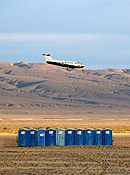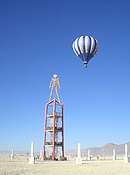What’s the biggest obstacle encountered while building an airport in the desert? This year the great challenge was Mother Nature’s fault. Lack of winter rains created a surface worse than any pilots had seen since the inception of Burning Man. The placement of the airport relative to Black Rock City is constrained by prevailing winds, ground traffic and aerial traffic. The safest spot for air operations forced the runway location into poor surface conditions. It was a trade-off and the consensus was that a taxiing accident due to a soft surface would be preferable to a head-on collision in the air.
One plane crashed on take-off and one had a mishap in the tie down area with collapsed landing gear, but neither incident appeared related to the soft surface. The runway was tolerable after smoothing, watering, and packing, but the area between the runway and the tie down area was poor at best. A taxiway was added, though it left much to be desired. Several planes were stuck briefly (thankfully not on the runway), and were pushed out by a crew of volunteers. Despite the surface and several windstorms, we had 123 aircraft registered (less than in 2007), and many transient flights.

The greatest improvement in aviation safety was a new UNICOM radio base station. The more powerful transmitter and antenna provided clear and reliable communications between the ground-based advisor and pilots. No matter how good the transmitter, it can’t reach a pilot who’s not listening on the right frequency (such as the one flying a large helicopter who made several unapproved low passes over the city).
Skydivers provided an aerial ballet with fireworks Friday evening. To do this safely, they put together a very impressive plan with temporary lighting on the runway, a landing zone safety crew, radio communications between the pilot and ground crew, training, and backup plans. The performance went off without a hitch and was much enjoyed from the ground.

Burning Man Earth took the skies again this year, taking high-resolution aerial photography of the city. Several pilots provided the platform for the photos. You can read more about this project and virtually fly over the city yourself on Burning Man Earth. If you wish to look around the airport before “take-off”, check out images on Gigapan.. You can search using “Burning Man Airport” to find more.
The Federal Aviation Administration (FAA) stopped by several times during the week to check on operations and went away satisfied. The Nevada Department of Transportation (NDOT) also came by to do their annual airport inspection. They schedule us well in advance; there’s no point in showing up a week early or a week later when the airport is gone. NDOT publishes an airport directory with a thick section titled “Nevada Public Use Airports”. The last edition added a very thin section titled “Annual Temporary Airport”. You can download the entire guide or skip to the Black Rock Airport section.
The volunteers who built, staffed, and deconstructed the airport, were fantastic as usual. Dedicated crews had the basic framework completed in good time despite adverse conditions, and most were able to stay post-event for deconstruction. The Ministry of Customs underwent a small reorganization with several new ministers recruited to share the on-playa workload. The larger group is now graciously guided by a Queen of Customs. Customs and Unicom volunteers valiantly stayed on duty through the dust storms to support new arrivals who’d take advantage of short breaks in the storms to land. Some volunteers liked the work enough to sign up for extra shifts later in the week, and voiced their intent to return in 2009. Everyone is looking forward to creating another safe and fun airport next year.
Submitted by,
Lissa Shoun, aka Tiger Tiger
Airport Manager, Black Rock International

